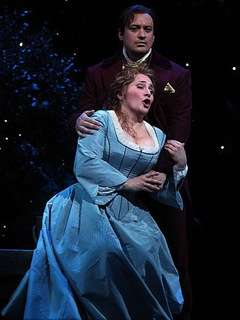|
Back
Dealing With the Devil San Francisco
War Memorial Opera House
06/05/2010 - & June 8, 11, 16, 20, 23, 26, July 1
Charles Gounod: Faust
Stefano Secco (Faust), Patricia Racette (Marguerite), John Relyea (Méphistophélès), Brian Mulligan (Valentin), Daniela Mack (Siébel), Catherine Cook (Marthe), Austin Kness (Wagner)
San Francisco Opera Orchestra and Chorus, Ian Robertson (chorus director), Maurizio Benini*/Giuseppe Finzi (conductor)
Jose Maria Condemi (director), Robert Perdziola (production designer), Duane Schuler (lighting designer), Lawrence Pech (choreographer), Kristi Johnson (costumes)

(Courtesy of San Francisco Opera)
San Francisco Opera presented the premiere season performance of Charles Gounoud’s Faust on June 5. Tenor Stefano Secco made his debut in the starring role. Lyric soprano Patricia Racette presented a superbly nuanced Marguerite, and John Relyea’s Méphistophélès was superb as The Prince of Darkness. Maurizio Benini conducted the San Francisco Opera Orchestra, adhering to a tempo, which, though somewhat measured, offered an aurally lush accompaniment.
As is so often the case, the villain nearly stole the show. Mr. Secco, clearly capable of a lyric and large sound, at times sounded a bit thin. This may well have been a mannerism to underscore the weakness of Faust’s character, but if so, was of questionable effect. Mr. Secco’s acting was mostly quite persuasive, but again, at times a little less so. These issues assuredly will be resolved with a few more performances. Whether the vast disparity in height between Faust and Méphistophélès was planned, it contributed to the “Otherness” between Man and the Devil. Mr. Relyea excelled as a demon. Clearly, he has the benefit of maturity and experience with this particular opera company, and he obviously enjoyed creating the vilest of villains. Better men than Faust have discovered that Evil is a mighty and overwhelming temptation to resist, and this poor soul, though weak-willed, was resolute until Lust beckoned in the form of Marguerite.
Ms. Racette offered a beautifully faceted Marguerite. The foreshadowing of her near-capitulation to Evil was strongly conveyed with spontaneous effect during the Jewel Song. Unfortunately, chemistry between her and Mr. Secco was a bit weak. Nevertheless, the pathos she projected during the weaving scene, and the despair of the dungeon, carried her Marguerite extremely well. Her voice needs more flexibility to make the Jewel Song adroit, but again, Ms. Racette’s excellent acting and artistry conveyed what her voice did not. More than one Marguerite has had difficulty with this coloratura section, given that the rest of the vocals are written for a lyric or dramatic soprano. However, this Marguerite was portrayed with tenderness, passion, and depth, and it was easy to sympathize with her experience.
Mezzo-soprano Catherine Cook as Marthe and baritone Brian Mulligan as Valentin both rendered heartfelt, fully engaged performances. Mr. Mulligan played his role consistent with a soldier’s values - the black versus white of wrong against right. His deep devotion turns to revulsion when Marguerite is disgraced. The chorus was in fine form, clearly having been carefully coached. Daniela Mack portrayed Siébel, a breeches role, with expressiveness and delicacy. Austin Kess (Wagner) provided fine support to the leads.
The stage set, courtesy of Robert Perdziola, was meticulously crafted according to the mood. Especially magnificent were the evening garden scene and, at the conclusion, the stairway leading out of the dungeon and into the sunlight. Costuming was uneven; Marguerite could have been attired a little more seductively when Méphistophélès conjured her image to banish Faust’s hesitation and send him on the path to Hades. In addition, although the potato sack donned at the scene of her disgrace was certainly appropriate, it would have been made a more effective dramatic tool as contrast when the opera switches focus from Faust to Marguerite. (This switch is one reason why Faust is problematic. It is up to the interpreter to rectify, if possible, the composer’s/librettists’ weaknesses.) San Francisco Opera’s production effectively glossed over the structural challenge; the transition from focusing on Faust to Marguerite was accomplished with a graceful segue.
It would have been nice had Marguerite had some white, organza-like cloak and slippers at the time of her curtain call so that she would not have had to take her accolades barefoot and attired in rags.
This Faust, while not a definitive production, was certainly enjoyable and easily met the high standards which San Francisco opera goers have come to expect. Although it is a lengthy work, the production never dragged. Highly recommended.
Claudia K. Nichols
|